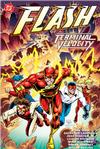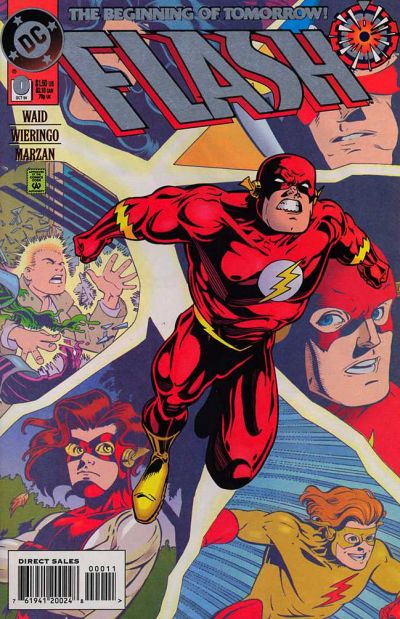
In 1994 DC Comics published Zero Hour, a five issue mini-series designed to not only serve as a major summer crossover but also fix some of the continuity problems that had plagued their universe after the end of Crisis on Infinite Earths. Some have suggested that Zero Hour caused more problems than it fixed but at the time it was the dawn of an exciting new era for DC. To kick off this new age DC followed Zero Hour with Zero Month. As the name suggests all of the main DC books were rolled back to zero though each one had a different approach to the idea Some books featured a new origin. Some contained tweaks to the existing origin. Some contained brand new versions of old characters. All of them served as a jumping on point for new and old readers alike.
To celebrate this new era (or perhaps to bury it) some of us in the comic book blogging community have banded together from remote galaxies to discuss how the characters we cover were rebooted/revamped by looking at the solicitations of our character’s zero issues as well as delving into the Wizard Magazine Zero Hour Special, which was a magazine published around the time of Zero Hour to promote the series, what was coming next and the history of DC in general.
Back in the Day…
With Zero Hour being sort of a follow-up to Crisis on Infinite Earths, someone at DC thought that killing off the Flash — or at least appearing to — would be a way to tie back to the already-classic story. But the Flash creative team had other plans.
In 1994, Wally West had been the main Flash for eight years and his series was approaching issue #100. (This was back when the typical comic book story ran one or two issues, maybe three. Four-issue stories were occasions, and a six-issue story meant Serious Business.) Mark Waid and Mike Wieringo had just introduced Impulse, Wally’s cousin and Barry Allen’s grandson, and brought back Iris Allen from the future. And they had slowly been bringing together DC’s other speedsters: Semi-retired Flash Jay Garrick, Johnny Quick, a renamed Max Mercury (originally called Quicksilver), and Johnny Quick’s daughter Jesse Quick.
Wait: a Crisis needs a dead Flash, and we’ve got a lot of speedsters around?
That’s right: it was time to play pick the successor.
But not right away.
Wally did vanish during Zero Hour, but didn’t die. He bounced around in time, met a younger version of himself at a critical moment in his past, and made it back just in time for his optimistically-named Welcome Back party to avoid admitting to itself that it was really a wake.
But he’d seen a vision of the future — one without him in it, or his then-girlfriend Linda Park — and something had changed in himself: Now, whenever he started running too fast, he began transforming into energy, losing a bit more of his humanity each time.
Terminal Velocity and the Speed Force
Zero Month set the stage for Terminal Velocity, which brought all the speedsters together and introduced the Speed Force. It’s been expanded greatly since then, but in those pages the idea was simple: It was an extra-dimensional energy field that all speedsters tapped into for their powers. The downside: they ran the risk of losing themselves if they drew too much. Max Mercury had come close many times only to pull back at the last moment, finding himself years in the future each time. An emotional anchor could help: Jay Garrick had felt the call, but held fast to earth and his relationship with Joan.
It was a neat trick: It tied all of DC’s speedsters together. It provided an easy answer to “Why doesn’t the Flash burn out in five seconds?” and similar questions — the energy’s coming from somewhere else. And it put a damper on the powers, one that could be adjusted as each plot required it.
By the end of Terminal Velocity, Wally West did indeed lose himself to the Speed Force. It felt like heaven. It held all the answers he’d ever wanted.
But he came back.
Because Linda wasn’t there.
A few years later, I read something Mark Waid had written about Terminal Velocity (maybe the afterward in the collected edition). Some readers had given them flak for having Wally return after all that talk about how nobody ever returns. Waid’s response: Whenever you start a story by explaining that no one has ever returned from the cave of death, chances are good that this is the story about the first person who does it.
Another bit from the same article: Amid all the epic destruction and battles, when it comes down to it, they were writing a love story.
And you know what? That’s what sticks in my head too. Not the near-destruction of Keystone, or the conflicts between Wally, Jesse and Bart, or the super-speed antics, or everyone in the DCU going up against Kobra’s organization. And sure, the consequences were far-reaching: It was ages before Jesse trusted Wally again. He and Bart could barely stand to be around each other. And knowing about the speed force gave Wally a few extra tricks up his sleeve, and of course that leads to the question of who else might know even more about the speed force…
But for me, the key moment of Terminal Velocity is right there at the end, when everyone’s convinced Wally’s gone, and Linda runs off, and Wally finally makes it back to her.
Everyone else can get the good news later.
As this is a blog crossover be sure to check out the links below to find out how other characters were treated during ZeroMonth.
- Firestorm Fan
- The Aquaman Shrine
- The Legion of Super Bloggers
- Pop Culture Affidavit
- The Fortress of Baileytude
- Corps Conjecture
- Being Carter Hall
Thanks to Michael Bailey of the Fortress of Baileytude and Jeffrey Taylor of From Crisis to Crisis for organizing this event, providing scans (except for the cover, which is from comics.org), and writing the introduction text.

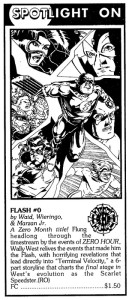
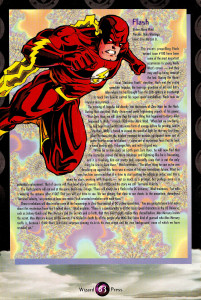
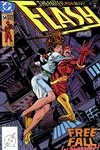

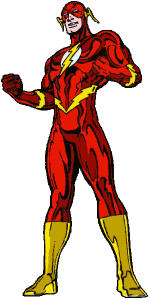 Comics Should Be Good has posted the
Comics Should Be Good has posted the 

